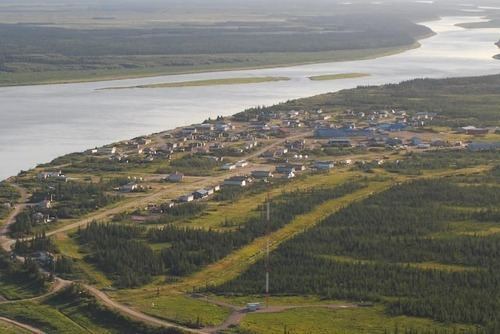First Nation Fort Severn Number of airports 1 | Population 334 (2011) Local time Wednesday 12:40 AM | |
 | ||
Website fortsevern.firstnation.ca Weather -17°C, Wind S at 11 km/h, 84% Humidity | ||
Fort Severn First Nation is a Cree First Nation band government located on Hudson Bay and is the most northern community in Ontario, Canada. In 2001, the population was 401, consisting of 90 families in an area of 40 square kilometres. The legal name of the reserve is Fort Severn 89, with the main settlement of Fort Severn.
Contents
Map of Fort Severn, ON, Canada
The town is linked by winter/ice road called the Wapusk Trail in the winter to Peawanuck, Ontario in the east, and Shamattawa and Gillam, Manitoba to the west.
Fort Severn is policed by the Nishnawbe-Aski Police Service, an Aboriginal-based service.
History
This area was inhabited for thousands of years by varying cultures of indigenous peoples. At the time of European contact, the historic Swampy Cree, and Algonquian-speaking people, lived in the area.
In 1689 the Hudson's Bay Company built Fort Severn at this site; it was one of the earliest English fur trading posts in the New World. After years of international competition between the English and French, with their wars playing out in North America, the French attacked the outpost and pillaged it in 1782 when they were allies of the Thirteen Colonies during the American Revolutionary War.
In the early 20th century, when the federal government negotiated a treaty with the First Nations, it set aside land for a native reserve in the Rocksand area at the confluence of the Severn and Sachigo Rivers, with the consent of the leaders at the time. In 1973, the reserve was relocated to the mouth of the Severn River on Hudson Bay, for more direct access to shipping. The reserve achieved full status on January 11, 1980.
Government
The local band council consists of an elected chief, a deputy chief, and four band councilors.
Community services
There is no hospital in Fort Severn with either medical needs provided at local nursing station or via Keewaytinook Okimakanak Telemedicine (KOTM) link.
Transportation
There are only local roads in town and residents travel by car, snowmobile or walking.
The Fort Severn Airport is located a short distance from the settlement and is accessible by an access road.
Education
Wasayo First Nation School is the only full functioning school providing primary education needs. Keewaytinook Internet High School is housed in a small building and provides distance learning for residents needing secondary education.
